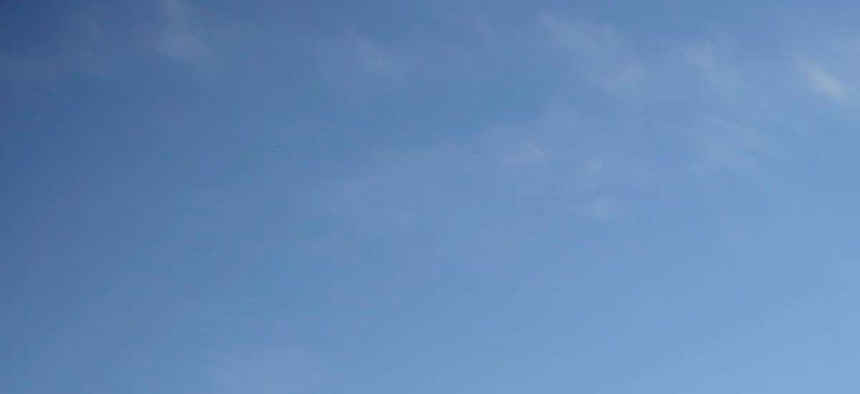
Police in riot gear watch protestors in Ferguson, Mo., on August 13, 2014. Jeff Roberson/AP
Police in Ferguson May Have the Look But They Lack the Tactics of Soldiers
U.S. veterans are pointing out they patrolled Iraq, Bosnia and South America with less equipment and weaponry than police in Ferguson. By David Yanofsky
The protests following the shooting of Michael Brown in Ferguson, Missouri—a suburb of St. Louis in the middle of the US—have put on wide display the surprising level to which US local police has been militarized. Police have manned the demonstrations in armored transports, while wearing combat boots with bloused camouflage pants, helmets, gas masks, and bullet-proof vests. Many have carried military-style rifles.
Some US veterans took to Twitter to point out that they invaded Iraq, patrolled Bosnia, monitored the Korean DMZ, or interdicted drug smugglers in Honduras with less protective equipment and more rudimentary weaponry than they were seeing in Ferguson.
But if the officers in Ferguson at times could be mistaken for the US Army, they don’t seem to be adhering closely to the Army’s playbook when it comes to operational tactics. Army Training Publication 3-39.33 (pdf) is a 132-page document outlining the procedures US Army personnel should follow when on duty at demonstrations, protests, and riots, at home or abroad. Officers in Ferguson are using some of the tactics described in this guide: a “graduated response,” employing dogs as a show of force, and containing crowds with roadblocks, for example. But some of the strategic considerations urged in the guide appear to be absent.
For instance, the guide has tips for “pre-incident planning”:
Planning should focus on the prevention of unfavorable outcomes. Experience has shown some law enforcement agencies attempting to help crowds accomplish their goals within the law has been beneficial and even led to conceding some violations for the purpose of avoiding confrontation. However, law enforcement agencies maintains a law enforcement presence, which signifies social restraint.
Rather than “conceding some violations for the purpose of avoiding confrontation,” police in Ferguson seem to be enforcing the letter of the law. Many of the hostile interactions between police and protesters shared on social media by protesters are described as a result of demonstrators walking or standing in the street instead of the sidewalk.
The guide advises officers to “avoid confrontation”:
Crowd situations are highly unpredictable, but history has proven that confrontation will most likely cause crowd resistance. When pushed, people tend to resist opposition to the realization of their purposes.
And it tells commanders to be aware of crowd perception:
Take precautions to avoid becoming a catalyst to the civil disturbance. Do not display civil disturbance equipment or weapons, overtly prepare defenses against a crowd, or aggressively violate crowd space, unless presented with information, intelligence, or negative indicators of pending violence.
Some news photos from Ferguson show officers peering through weapon scopes at what appear to be peaceful protesters, and lines of tactical officers armed with rifles near demonstrations. Other pictures show less militarized officers with just batons, helmets, and face shields.
The guide also counsels an awareness of community and media perception:
Projecting a favorable image will require outreach to local leaders and citizens. It will also require developing a relationship with the media. For example, the Los Angeles Sheriff’s Department often invites the media to accompany their tactical commander during crowd control situations. This shows that they have nothing to hide. It also provides an opportunity for individuals to see the commander’s side of an event.
Yesterday—on August 13—two reporters, Wesley Lowery of the Washington Post and Ryan Reilly of the Huffington Post, were detained after an armed team of officers descended upon the McDonald’s they were working at, according to their accounts.
The guide has seven pages on crowd dynamics and behavior theories, including this warning about using substances such as tear gas and pepper spray:
The use of riot control agents by authorities adds to the panic and confusion. Individuals in a mob may attempt to leave the area, and then they may find that there are no escape routes and the roads are blocked. This can often lead to violent physical attacks.
The police in Ferguson have used tear gas—a type of nerve gas banned for use in warfare by the Chemical Weapons Convention of 1993—to disperse protests. Ferguson may look like a war zone today, but is not subject to the treaty.
NEXT STORY: Civilians in Iraq to Get Higher Premium Pay



